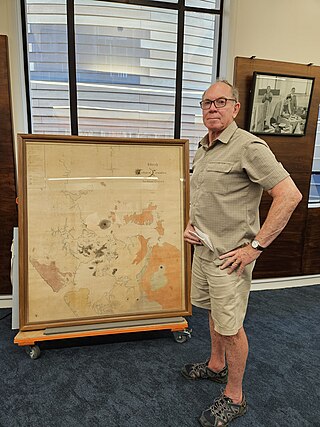
Carter County is a county in the Ozarks of Missouri. At the 2020 census, it had a population of 5,202. The largest city and county seat is Van Buren. The county was officially organized on March 10, 1859, and is named after Zimri A. Carter, a pioneer settler who came to Missouri from South Carolina in 1812.

George Mercer Dawson was a Canadian geologist and surveyor. He performed many early explorations in western North America and compiled numerous records of the native peoples.

Fennoscandia, or the Fennoscandian Peninsula, is a peninsula in Europe which includes the Scandinavian and Kola peninsulas, mainland Finland, and Karelia. Administratively, this roughly encompasses the mainlands of Finland, Norway and Sweden, as well as Murmansk Oblast, much of the Republic of Karelia, and parts of northern Leningrad Oblast in Russia.

James Hall Jr. was an American geologist and paleontologist. He was a noted authority on stratigraphy and had an influential role in the development of paleontology in the United States.

Arthur Philemon Coleman was a Canadian geologist and academic.
William Walden Rubey was an American geologist.

Sir Albert Charles Seward FRS was a British botanist and geologist.

Henry Gannett was an American geographer who is described as the "father of mapmaking in America." He was the chief geographer for the United States Geological Survey essentially from its founding until 1902.

John James Stevenson was an American geologist, born in New York City. He graduated from New York University in 1863, became professor of chemistry at West Virginia University for two years (1869–71), then served as professor of geology at New York University until 1909. During 1873–74 and from 1878 to 1880 he was geologist for the United States Geological Survey. He also served on the Pennsylvania Geological Survey from 1875 to 1878 and from 1881 to 1882. He was president of the Geological Society of America in 1898.

Robert Merlin Carter was an English palaeontologist, stratigrapher and marine geologist. He was professor and head of the School of Earth Sciences at James Cook University in Australia from 1981 to 1998, and was prominent in promoting anthropogenic climate change denial.
Prof William Whitehead Watts FRS HFRSE FGS FMS LLD was a British geologist.

Ohio City is an unincorporated community and a U.S. Post Office in Gunnison County, Colorado, United States. The Ohio City Post Office has the ZIP Code 81237.

Benjamin Kendall Emerson was an American geologist and author.

Henry John Carter, FRS was a surgeon working in Bombay, India, who carried out work in geology, paleontology, and zoology. He worked as an army surgeon in Bombay from 1859 on Her Majesty's Indian Service, Bombay Establishment. He edited a collection of geological papers on Western India, including a summary of the geology of India, which was published in 1857. Many items of his published work appeared in the journal of the Bombay Branch of the Royal Asiatic Society, and in the Annals of Natural History. He was elected a Fellow of the Royal Society in 1859.

Henry Carter Adams was a U.S. economist and Professor of Political Economy and finance at the University of Michigan.

Edmund Johnston Garwood was a British geologist and President of the Geological Society of London from 1930 to 1932.
Winona is an unincorporated community in Fayette County, West Virginia, United States. Winona is 6 miles (9.7 km) east of Fayetteville. Winona has a post office with ZIP code 25942. The community has the name of Winona Gwinn, the daughter of a settler.

Marshman Edward Wadsworth was an American geologist and educator. He served as the first president of Michigan Technological University and was State Geologist of Michigan from 1888 through 1893.

In the Chicago mayoral election of 1899, Democrat Carter Harrison Jr. was reelected, winning a plurality of the vote and defeating Republican nominee Zina R. Carter, former Illinois governor John Peter Altgeld, as well as several minor candidates by a double-digit margin.

Bruce William Hayward is a New Zealand geologist, marine ecologist, and author. He is known as a leading expert on living and fossil foraminifera.
















